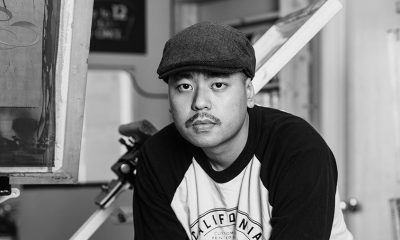Isaac Menge
Founder | Lady Lazarus Press | Houston
Age: 33 | Years in the Industry: 14
Words of Advice: “Collaboration, tolerance of alternate views, and the willingness to accept and learn from those around you can only lead to the success of all. I believe a strong, inclusive art community is a conduit for new ideas.”

Isaac Menge first pulled a squeegee in 2004 and has been pushing the limits of screen printing ever since. Menge initially partnered with a fellow musician/printmaker to open Pedal Printing in Buffalo, New York, specializing in hand-pulled prints for national and international touring musicians. He eventually relocated to Houston and joined Night Owls print shop as print partner, further solidifying his reputation as a rock star in the gig poster market. Menge went on to open Lady Lazarus Press in 2012, where he screen prints for the fine art, collectible film, and music poster industries with his wife, Aleisha Bayron-Menge, “a multitalented artist, illustrator, and professional framer.”
How did you get your start in specialty printing?
I ended up in the screen printing industry by mistake, as a drummer out of work. After high school, I entered an engineering science program at Alfred State College, playing music with my peers in local punk and indie bands in my free time. We were always looking for a way to produce merchandise on the cheap to help pay for a few hours in the recording studio or fund a tour. I said to my bandmates, “Let me give this a shot – I might be able to do this from my basement.” They laughed and said we’d need to hire a professional.
Soon, I was producing the merchandise not only for my own bands, but any other band we’d come in contact with on tour. I’d come home from my day job and spend the night printing shirts, record covers, gig posters, vinyl stickers, patches, and anything else I could stick below a screen. I’ve always immersed myself in anything I do: Printing became an obsession and I continued to push for better techniques and a more solid understanding of the art of printmaking. I spent about a year working for Great Arrow Graphics in Buffalo, New York, hand printing solvent-based ink onto greeting cards, which helped me dial into fine detail printing in a fast-paced, high-volume manufacturing atmosphere. Over time, the bands I played in faded away, friends moved on, and I decided I enjoyed making prints more than the degree I was pursuing. So against the advice of my loved ones, I left school to open a print studio in the living room of an apartment in Buffalo.
Advertisement
You’ve produced work ranging from gig posters and stickers to fine art printing: Tell us about your favorite project that presented some challenges but turned out great in the end.
The joy I find in printmaking is the challenge. I am always looking for new ways to hide the seams in our work, achieving a final edition that not only executes the artist’s original intent and vision, but hopefully adds additional dimension, texture, depth, and color to make up for anything which may have been lost throughout the filtration process of printing. As Kelly Clarkson, er, I mean, my parents and Friedrich Nietzsche have always said: “What does not kill me makes me stronger.” Projects stick in my mind when they almost take me down – that is, when I tend to gain the greatest knowledge. Typically, those projects will not turn out looking as good as you’d like, and at times they’ll flip you upside down financially. But if you’re paying attention, you’ll know exactly how to approach the artist’s body of work the next go-around.
There is one in particular that stands strong in my mind, titled “Nadeshiko” (pictured). It was created by the Japanese street artist RoamCouch (Ryo Ogawa). Ryo produces beautiful, elaborate, hand-cut spray paint stencil work in large format. The piece I was approaching at the time required a rework of the digital color separation, color ordering, trapping, and technique. The proposed image, based off of his finished spray paint work, did not seem achievable in print to the publisher. It had been simplified to meet the “limitations” of the screen printing process. The piece, which was a portrait of a geisha surrounded by butterflies, was misleadingly bold and simple in composition at first glance, but it included various subtle gradations of tone, and bright, almost fluorescent gradients in the wings of the butterflies. I explained that although most printers had suggested simplifying the work or using a form of four-color process in areas, I’d prefer to match the printed edition as closely as possible to the aerosol original. Quickly, I suggested using a diffused layering of soft, transparent gray tones to capture the shadows and gradations in the umbrella, and why not print the seven butterflies with split fountain blends?

In the blink of an eye, we were up to 40 colors, printing seven tiny 3-inch-wide split fountain blends by hand, at seven different angles, in perfect registration with no registration marks or grid, before moving the project from our hand table to one of the larger semiautomatic flatbed presses. I soon found, after spending 40-plus hours painfully pulling micro split fountains onto each sheet by hand and remixing the short blends after each pull, that the ink we used as a base to stabilize the paper had a strong chemical resistance to the heavier coverage opaque layers we’d be printing later on. It took a hybrid buildup of acrylic, water-based, and solvent ink to work past the adhesion issue. Plenty of mistakes were made throughout the process and time evaporated, but in the end, the edition did look beautiful. The new techniques I worked out for this project and the endless hours on press have helped troubleshoot plenty of projects since.
Read more about Screen Printing‘s 2018 Rising Stars Award winners.

 Art, Ad, or Alchemy1 month ago
Art, Ad, or Alchemy1 month ago
 Case Studies1 month ago
Case Studies1 month ago
 Andy MacDougall1 month ago
Andy MacDougall1 month ago
 Columns2 weeks ago
Columns2 weeks ago
 Editor's Note2 weeks ago
Editor's Note2 weeks ago
 Thomas Trimingham2 months ago
Thomas Trimingham2 months ago
 Marshall Atkinson2 weeks ago
Marshall Atkinson2 weeks ago
 News & Trends1 month ago
News & Trends1 month ago

















